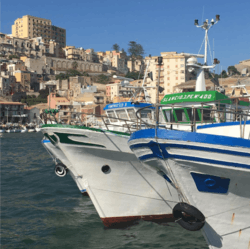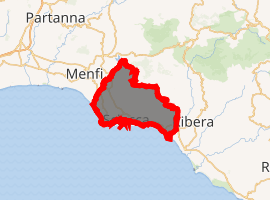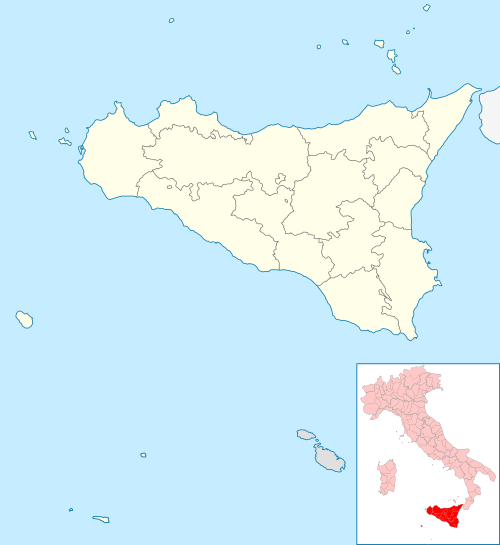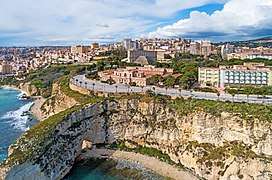Sciacca
Sciacca (Italian: [ˈʃakka]; Greek: Θέρμαι; Latin: Thermae Selinuntinae, Thermae Selinuntiae, Thermae, Aquae Labrodes and Aquae Labodes), is a town and comune in the province of Agrigento on the southwestern coast of Sicily, southern Italy. It has views of the Mediterranean Sea.
Sciacca | |
|---|---|
| Comune di Sciacca | |
 | |
 Coat of arms | |
Location of Sciacca 
| |
 Sciacca Location of Sciacca in Italy  Sciacca Sciacca (Sicily) | |
| Coordinates: 37°30′33″N 13°5′20″E | |
| Country | Italy |
| Region | Sicily |
| Province | Agrigento (AG) |
| Frazioni | Lazzarino |
| Government | |
| • Mayor | Francesca Valenti |
| Area | |
| • Total | 191.67 km2 (74.00 sq mi) |
| Elevation | 60 m (200 ft) |
| Population (31 March 2017)[2] | |
| • Total | 40,569 |
| • Density | 210/km2 (550/sq mi) |
| Demonym(s) | Saccensi, Sciacchitani |
| Time zone | UTC+1 (CET) |
| • Summer (DST) | UTC+2 (CEST) |
| Postal code | 92019 |
| Dialing code | 0925 |
| Patron saint | Holy Mary of Soccorso |
| Saint day | 2 February |
| Website | Official website |
History
Thermae was founded in the 5th century BC by the Greeks, as its name imports, as a thermal spa for Selinunte, whose citizens came there to bathe in the sulphurous springs of Mount San Calogero, which rises up behind the town. We have no account of the existence of a town on the site during the period of the independence of Selinunte, though there is little doubt that the thermal waters would always have attracted some population to the spot. Nor even under the Romans did the place attain to anything like the same importance with the northern Thermae; and there is little doubt that Pliny is mistaken in assigning the rank of a colonia to the southern instead of the northern town of the name. Strabo mentions the waters (τὰ ὕδατα τὰ Σελινούντια[3]); and they are again noticed in the Itineraries under the name of Aquae Labodes or Labrodes.[4]
The origins of the town's name have been much debated, with Latin "ex acqua", as a reference to the springs of thermal water of the area, or Arabic "Syac", meaning bath, and al Saqquah, dating back to the cult of the Syrian god "Shai al Quaaum", as possibilities.
The city walls, the bastions and the Old Castle owe their existence to Roger the Great Count.
A royal city which had remained faithful to Manfred of Sicily during the Angevine invasion, by 1268 A.D. it was besieged by Charles I of Anjou and surrendered the following year. After the Sicilian Vespers, it established itself as a free commune. During the Aragonese-Angevine wars it was besieged numerous times, after which the Peralta family took possession of it and obtained by the king of Sicily the right to mint coins. In the following centuries the town was at the center of bloody feuds between rival baronial families (the Luna, of Aragonese origin, and the Perollo, of Norman stock), which nearly halved its population. In 1647 the impoverished town was the seat of an anti-Spanish rebellion.
During World War II the Italian Regia Aeronautica (Royal Air Force) had a base near Sciacca.
Geography
Overview
The municipality borders Caltabellotta, Menfi, Ribera and Sambuca di Sicilia.[5]
Climate
Sciacca has a Mediterranean climate (Köppen climate classification: Csa),[6] with short, mild and moderately rainy winters and long, hot and dry summers. The city receives around 450 millimeters (17.7 inches) of rain per year, experiencing a peak of 72.3 millimeters (2.8 inches) in November and a minimum of 2.5 millimeters (0.1 inch) in July.
| Climate data for Sciacca, Italy | |||||||||||||
|---|---|---|---|---|---|---|---|---|---|---|---|---|---|
| Month | Jan | Feb | Mar | Apr | May | Jun | Jul | Aug | Sep | Oct | Nov | Dec | Year |
| Average high °C (°F) | 15 (59) |
15 (59) |
17 (63) |
19 (66) |
23 (73) |
27 (81) |
30 (86) |
30 (86) |
28 (82) |
24 (75) |
19 (66) |
16 (61) |
22 (71) |
| Average low °C (°F) | 8 (46) |
8 (46) |
9 (48) |
10 (50) |
13 (55) |
17 (63) |
19 (66) |
20 (68) |
18 (64) |
15 (59) |
12 (54) |
9 (48) |
13 (56) |
| Average rainfall mm (inches) | 56 (2.2) |
46 (1.8) |
45 (1.8) |
37 (1.5) |
17 (0.7) |
5 (0.2) |
2 (0.1) |
9 (0.4) |
42 (1.7) |
61 (2.4) |
65 (2.6) |
65 (2.6) |
450 (18) |
| Mean daily sunshine hours | 4 | 5 | 6 | 7 | 9 | 10 | 11 | 10 | 9 | 7 | 5 | 4 | 7 |
| Source: Meteo Italia (ilmeteo.it)[7] | |||||||||||||
Main sights
Sciacca still retains much of its medieval layout, which divided the town into quarters, each laid out on a strip of rock descending toward the sea. Sciacca has several points of interest, including:
- the Cathedral of Maria SS. del Soccorso (12th century, rebuilt in 1685)
- the Castle of the Counts Luna. Of the Old Castle scarce remains can be still seen.
- Church of Santa Margherita
- Chiesa del Carmine
- Church of San Michele (1371, rebuilt in the 17th century)
- Church of Santa Maria delle Giummare
- Palazzo Steripinto
- Palazzo Tagliavia (11th century), in Neo-Gothic style
- Palazzo Perollo (15th century)
Culture
Sciacca's festivals include the Carnival, celebrated during the week before the beginning of Lent (February). The highlight of the festival is the parade of bizarre figures mounted on floats, famous throughout Sicily for their gaudy expressions. Sciacca is also the hometown of the Mediterranean Scene.
Starting near the turn of the 20th century, a number of residents of the Sciacca area emigrated to the North End of Boston, Mass., where, starting in 1910, around August 15, their descendants, especially those from fishing families, have celebrated the Festival of the Madonna del Soccorso .
The local television stations are TRS Tele Radio Sciacca and 'RMK Tele Radio Monte Kronio'.
Economy
The economy of Sciacca is mainly based on agriculture, fishing and related food processing industry and tourism.
Gallery
_-_Sicily.jpg)
_View_from_Piazza_Scandaliato.jpg) View from Piazza Scandaliato
View from Piazza Scandaliato
_spiaggia_di_Timpi_russi-_Sicily.jpg) Beach of Timpi
Beach of Timpi
Sister cities



People
- Cataldo Amodei, Baroque liturgical composer
- Giuseppe Mario Bellanca, airplane designer who created the first monoplane in the United States with an enclosed cabin
- Johnny Dundee, world featherweight and super featherweight champion
- Tommaso Fazello, authored the first printed history of Sicily
- Giovanni Antonio Medrano, one of the architects who designed the San Carlo opera house in Naples
- Andrea Tummiolo, footballer
- Anthony Fauci, Director of the US National Institute of Allergy and Infectious Diseases, ancestry traced to Sciacca
References
- "Superficie di Comuni Province e Regioni italiane al 9 ottobre 2011". Istat. Retrieved 16 March 2019.
- "Popolazione Residente al 1° Gennaio 2018". Istat. Retrieved 16 March 2019.
- Strabo, vi. p. 275
- Itin. Ant. p. 89; Tabula Peutingeriana
- 39255 Sciacca on OpenStreetMap
- "World Map of Köppen−Geiger Climate Classification". Archived from the original on 2010-09-06.
- "Climate, temperatures and weather in Sciacca". www.thetraveller.co.uk. Retrieved 2020-06-18.
External links
| Wikimedia Commons has media related to Sciacca. |

- Guide to Sciacca (in Italian)